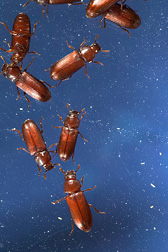Science Update
Anise—for Licorice, and Beyond
More than just a source of flavoring for sweets or liqueurs, the anise plant, Pimpinella sp., is turning out to be a potential source of new pharmaceuticals and agrochemical agents. Among some 22 compounds isolated from the plant’s essentials oils, researchers have found high levels of organic mixtures called phenylpropanoids. Though phenylpropanoids are also found in many other plants, the chemical structure and biological activity of those obtained from Pimpinella have proved to be unique. Some are only found in Pimpinella, and four have never before been identified in any plant.
The scientists tested the compounds for activity against various major and minor microbes, including Colletotrichum. This plant fungus causes anthracnose diseases in crops worldwide. One unique compound was especially effective against strawberry anthracnose and strawberry soft rot and leaf blight. Pimpinella essential oils and some phenylpropanoids also exhibited mild anti-inflammatory activities. The research was done with colleagues in Poplarville, Mississippi, and Eskisehir, Turkey.
Nurhayat Tabanca, USDA-ARS Natural Products Utilization Research Laboratory, Oxford, Mississippi; phone (662) 915-1009.
Weather factors can negatively affect cattle in feedlots in summertime. In addition to heat, physical stressors include humidity, sun intensity, and windspeed. To help livestock managers gauge the level of heat threat in their region, researchers have created a model that is updated twice daily. It analyzes weather forecast information, assesses the danger of heat stress, and displays that information as color-coded maps for a 7-day period.
The model makes predictions for western Colorado, Iowa, Kansas, southern Minnesota, Missouri, Nebraska, Oklahoma, South Dakota, and northern Texas. The maps it generates fill a void left by the mid-1990s discontinuance of livestock weather warnings that were previously issued by the National Weather Service. To view the maps, go to www.ars.usda.gov/Main/docs.htm?docid=17129.
Tami M. Brown-Brandl and Roger A. Eigenberg, USDA-ARS Roman L. Hruska U.S. Meat Animal Research Center, Clay Center, Nebraska; phone (402) 762-4279 [Brown-Brandl], (402) 762-4272 [Eigenberg].
|
|
First Beetle Blueprint Is Complete
Another creature recently joined the ranks of model organisms whose entire genetic blueprints, or genomes, have been sequenced and annotated: the red flour beetle (Tribolium castaneum). The feat was accomplished by a consortium of more than 100 scientists representing 14 countries.
A significant pest of stored grain and grain products all over the world, T. castaneum is a voracious feeder and a major contributor to infestations that cost millions of dollars in food and feed losses annually. It is also the first key agricultural pest to have its genome sequenced—and the first beetle. Researchers hope that they’ll be able to use this inside information to develop new ways to curb the pest’s raids on the world’s granaries. For example, they want to know how T. castaneum can adapt to a wide variety of diets and environmental conditions, so they might one day curb that adaptability genetically.
Richard W. Beeman, USDA-ARS Grain Marketing and Production Research Center, Manhattan, Kansas; phone (785) 776-2710.
Hardy Safflowers for Colder Climes
Three new safflower germplasm lines are now available to breeders interested in improving the winter survival, or hardiness, of this oilseed crop—especially in the West and the Southern Great Plains. Safflower is usually grown for its oil, which is mainly used for cooking and in salad dressing and margarine, but can also be used in paint bases and biodiesel. The high-fiber, high-protein meal left after crushing and extracting oil from the safflower seeds is fed to livestock, while intact seeds are marketed as birdseed. The plant’s red flowers are used in dyes.
These new lines—derived from three Chinese safflower accessions—are the first U.S. safflower releases developed specifically for winter hardiness. In field trials, the plants grew upright to nearly 3 feet and contained, on average, 80 percent linoleic acid and 14 percent oleic fatty acid. With additional breeding, they should offer farmers a number of benefits, including a fall planting option, winter ground cover, rotation with other crops like wheat, better weed control and water-use efficiency, and higher seed yields than spring-planted safflower crops.
Richard C. Johnson, USDA-ARS Plant Germplasm Introduction and Testing Research Unit, Pullman, Washington; phone (509) 335-3771.
"Science Update" was published in the September 2008 issue of Agricultural Research magazine.







